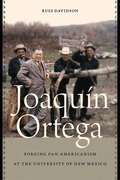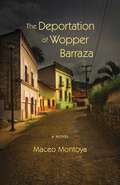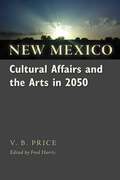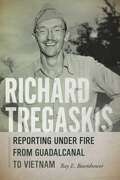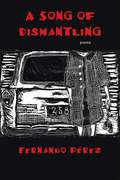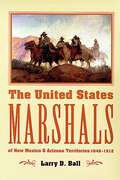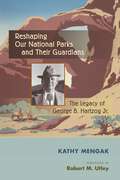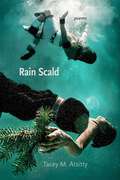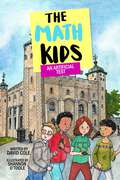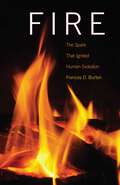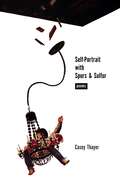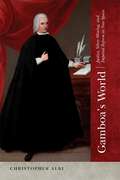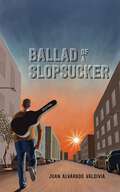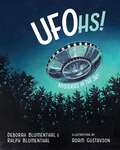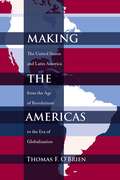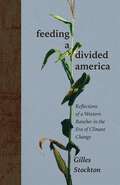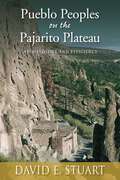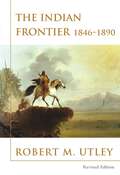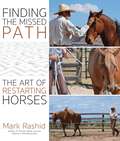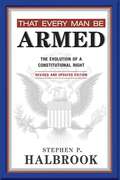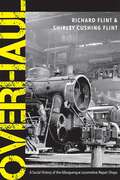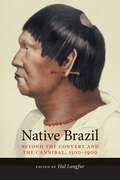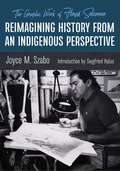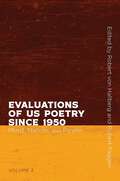- Table View
- List View
Joaquín Ortega: Forging Pan-Americanism at the University of New Mexico (Contextos Series)
by Russ DavidsonIn this important work Russ Davidson presents the first biography of Joaquín Ortega, introducing readers to Ortega&’s life and work at the University of New Mexico as well as his close relationship with then UNM president James Zimmerman and other major figures. More than biography, Davidson&’s study closely examines the complex relationship UNM has had with Latin America as well as with the Hispanic community in New Mexico and that community&’s struggles to have equal representation of culture and education within an Anglo-dominated university and state in the first half of the twentieth century. Ortega&’s efforts played a significant role in UNM&’s evolution into a culturally diverse place of learning, and his story overlays the history of how ethnic groups began to work together to incorporate Latin American, Pan-American, New Mexican, and borderland studies into the educational fabric of the university at a pivotal time. This long-overdue volume is an illuminating look at the rich and complex history of the university and the communities it serves.
The Deportation of Wopper Barraza: A Novel
by Maceo Montoya&“A brilliant and innovative take on an issue close to the hearts and minds of families who have one foot planted firmly on both sides of the border. It is a deportation story in reverse: a bold re-envisioning with unexpected consequences, mystery, and insight.&”—Tim Z. Hernandez, author of Mañana Means HeavenAfter Wopper Barraza&’s fourth drunk driving violation, the judge orders his immediate deportation. &“But I haven&’t been there since I was a little kid,&” says Wopper, whose parents brought him to California when he was three years old. Now he has to move back to Michoacán. When he learns that his longtime girlfriend is pregnant, the future looks even more uncertain. Wopper's story unfolds as life in a rural village takes him in new and unexpected directions. This immigrant saga in reverse is a story of young people who must live with the reality of their parents&’ dream. We know this story from the headlines, but up to now it has been unexplored literary territory.
New Mexico Cultural Affairs and the Arts in 2050
by V. B. PriceV. B. Price is an authority and an advocate in the field of New Mexican cultural affairs and the arts. In this E-short edition from New Mexico 2050, he focuses on how much the &“creative workers,&” those working in the arts and culture, are an essential part of what makes New Mexico New Mexico—what makes people want to live here, what makes people want to come here, what valuable contributions these creative workers make to the economy, and how much more they can contribute if New Mexicans more fully support and encourage their efforts.
Richard Tregaskis: Reporting under Fire from Guadalcanal to Vietnam
by Ray E. BoomhowerIn the late summer of 1942, more than ten thousand members of the First Marine Division held a tenuous toehold on the Pacific island of Guadalcanal. As American marines battled Japanese forces for control of the island, they were joined by war correspondent Richard Tregaskis. Tregaskis was one of only two civilian reporters to land and stay with the marines, and in his notebook he captured the daily and nightly terrors faced by American forces in one of World War II&’s most legendary battles—and it served as the premise for his bestselling book, Guadalcanal Diary.One of the most distinguished combat reporters to cover World War II, Tregaskis later reported on Cold War conflicts in Korea and Vietnam. In 1964 the Overseas Press Club recognized his first-person reporting under hazardous circumstances by awarding him its George Polk Award for his book Vietnam Diary. Boomhower&’s riveting book is the first to tell Tregaskis&’s gripping life story, concentrating on his intrepid reporting experiences during World War II and his fascination with war and its effect on the men who fought it.
A Song of Dismantling: Poems (Mary Burritt Christiansen Poetry Series)
by Fernando PérezIn this dynamic debut collection, Fernando Pérez employs lyric and nonce forms to interrogate identity politics and piece together a complex family history. The book embodies fragmentation in form and story, exploring how migration affects relationships between people of different generations. Pérez invites readers on the journey as his family story unfolds over time and distance.
The United States Marshals of New Mexico and Arizona Territories, 1846-1912
by Larry D. BallFirst released in 1978 and still the best account of territorial law enforcement, this book presents a thoroughly researched, well-documented, and entertaining history of United States marshals in New Mexico and Arizona during the tumultuous territorial years. Included in the story are notable lawmen such as John Pratt, John E. Sherman, and Creighton M. Foraker and gunfighters like Billy the Kid, Doc Holliday, and the Earp Brothers. With detailed accounts of many other lesser-known lawmen and criminals, Ball gives a well-rounded history of the mundane as well as the spectacular incidents in the lives of these lawmen during the unstable territorial years.
Reshaping Our National Parks and Their Guardians: The Legacy of George B. Hartzog Jr.
by Kathy MengakThis biography of the seventh director of the National Park Service brings to life one of the most colorful, powerful, and politically astute people to hold this position. George B. Hartzog Jr. served during an exciting and volatile era in American history. Appointed in 1964 by Secretary of the Interior Stewart Udall, he benefited from a rare combination of circumstances that favored his vision, which was congenial with both President Lyndon Johnson&’s &“Great Society&” and Udall&’s robust environmentalism.Hartzog led the largest expansion of the National Park System in history and developed social programs that gave the Service new complexion. During his nine-year tenure, the system grew by seventy-two units totaling 2.7 million acres including not just national parks, but historical and archaeological monuments and sites, recreation areas, seashores, riverways, memorials, and cultural units celebrating minority experiences in America. In addition, Hartzog sought to make national parks relevant and responsive to the nation&’s changing needs.
Rain Scald: Poems (Mary Burritt Christiansen Poetry Series)
by Tacey M. AtsittyIn this innovative debut collection, Tacey M. Atsitty employs traditional, lyric, and experimental verse to create an intricate landscape she invites readers to explore. Presented in three sections, Tséyi&’, Gorge Dweller, and Tóhee&’, the poems negotiate between belief and doubt, self and family, and interior and exterior landscapes.
An Artificial Test: The Math Kids (Book 8) (The Math Kids)
by David ColeAfter a tough end to the school year, the Math Kids—Jordan, Justin, Stephanie, and Catherine—take a jet to London for an exciting summer vacation. But between exploring the city and seeing the sights, they&’re quickly drawn into investigations of terrorist activity. Authorities are on high alert because of threats to landmarks across the city. But there&’s something odd about the messages. Working alongside Bobby, a police officer tasked with being their trip guide, the kids must uncover the true purpose of a mysterious online message board or risk being sent home early. With their vacation plans and the safety of London at risk, the Math Kids are in for their most complex case yet!Finalist for the Foreword INDIES Book of the Year AwardsAn abundantly diverting middle grade mystery seasoned with history and intrigue…A fast-moving plot, and the characters&’ fun banter will encourage even reluctant readers to test the waters. Full of mystery, puzzles, and intrigue, this solid, tightly plotted read is a winner for middle graders. Un-put-downable. - The Prairies Book Review
Fire: The Spark That Ignited Human Evolution
by Frances D. BurtonThe association between our ancestors and fire, somewhere around six to four million years ago, had a tremendous impact on human evolution, transforming our earliest human ancestor, a being communicating without speech but with insight, reason, manual dexterity, highly developed social organization, and the capability of experimenting with this new technology. As it first associated with and then began to tame fire, this extraordinary being began to distance itself from its primate relatives, taking a path that would alter its environment, physiology, and self-image. Based on her extensive research with nonhuman primates, anthropologist Frances Burton details the stages of the conquest of fire and the systems it affected. Her study examines the natural occurrence of fire and describes the effects light has on human physiology. She constructs possible variations of our earliest human ancestor and its way of life, utilizing archaeological and anthropological evidence of the earliest human-controlled fires to explore the profound physical and biological impacts fire had on human evolution.
Self-Portrait with Spurs and Sulfur: Poems (Mary Burritt Christiansen Poetry Series)
by Casey ThayerPart fun-house hall of mirrors in its distorted and dizzying central narrative, part spaghetti western, and part prayer, Self-Portrait with Spurs and Sulfur is an exploration into the possibilities of storytelling. Through persona poems and odes, the collection argues that the muddier the narrative, the closer the story gets to truth.
Gamboa's World: Justice, Silver Mining, and Imperial Reform in New Spain (Diálogos Series)
by Christopher AlbiGamboa&’s World examines the changing legal landscape of eighteenth-century Mexico through the lens of the jurist Francisco Xavier de Gamboa (1717–1794). Gamboa was both a representative of legal professionals in the Spanish world and a central protagonist in major legal controversies in Mexico. Of Basque descent, Gamboa rose from an impoverished childhood in Guadalajara to the top of the judicial hierarchy in New Spain. He practiced law in Mexico City in the 1740s, represented Mexican merchants in Madrid in the late 1750s, published an authoritative commentary on mining law in 1761, and served for three decades as an Audiencia magistrate. In 1788 he became the first locally born regent, or chief justice, of the High Court of New Spain. In this important work, Christopher Albi shows how Gamboa&’s forgotten career path illuminates the evolution of colonial legal culture and how his arguments about law and justice remain relevant today as Mexico debates how to strengthen the rule of law.
Ballad of a Slopsucker: Stories
by Juan Alvarado ValdiviaA young widower visits Chichén Itzá to honor his wife; family dynamics unravel at a child&’s birthday party; the lead singer of a high school metal band faces his dreaded tenth reunion; a serial killer believes he&’s been blessed by God to murder bicycle thieves—Alvarado Valdivia&’s debut collection of short stories ranges from dark to light and is written with a storyteller&’s skill and compassion. Based in Northern California and examining a variety of themes, including love, family, and masculinity, these stories offer an important new perspective on the experiences of Latinos and Latinas in the United States and complicate ideas of nationhood, identity, and the definition of home.
UFOhs!: Mysteries in the Sky (Barbara Guth Worlds of Wonder Science Series for Young Readers)
by Deborah Blumenthal Blumenthal RalphUFOhs! Mysteries in the Sky is the first book to explore the strange, exciting, and unknown world of unidentified aerial phenomena for kids. UFOhs! cuts through speculation and pseudo-science to describe real phenomena as observed and documented by pilots, ship captains, scientists, and ordinary men, women, and children from around the world. Playful, probing, and beautifully illustrated, UFOhs! Mysteries in the Sky prompts kids and their parents to talk about the moon, the stars, the planets, and all the things they see in the sky, and to wonder about those we can&’t yet explain.
Making the Americas: The United States and Latin America from the Age of Revolutions to the Era of Globalization (Diálogos Series)
by Thomas F. O'BrienAmericans' belief in their economic, political, and cultural superiority launched them on a mission to transform Latin America that has evolved into a global process of Americanization. From corporate and philanthropic initiatives to military interventions, Americans motivated by self-interest and idealism sought to reshape Latin America and gave birth to the American driven process of globalization. Synthesizing a broad range of international relations scholarship, including perspectives from gender, race, and cultural studies, O'Brien offers a sweeping history of the Americas that ranges from the adventures of eighteenth-century whaling men to the contemporary struggle over globalization. As a part of this study, the author explains how the responses of Latin Americans to Americanization have varied from the vehement rejection of U.S. economic dominance to embracing as well as reconfiguring the icons of American consumer culture. O'Brien's goal is to provide readers with a nuanced understanding of how the people of the Americas have shaped their own history, and influenced the development of U.S. economic, strategic, and cultural power in the world today.
Feeding a Divided America: Reflections of a Western Rancher in the Era of Climate Change (New Century Gardens and Landscapes of the American Southwest)
by Gilles StocktonIn Feeding a Divided America, third-generation Montana rancher and international agriculture development specialist Gilles Stockton explores the causes of what he refers to as the “rural-urban divide” and how this widening chasm between rural America and urban centers threatens our democracy. Indeed, it determines the structure of our society, including the physical and political landscapes in which we live. Stockton shows how big banks, international food conglomerates, urban expectations, and US farm policy have all furthered the demise of small towns across America.These essays provide a clear portrait of national food issues surrounding market competition, US trade policy, wildlife controversies, climate change, supply-chain disruptions, and US farm policy, topics that transcend all geopolitical boundaries. Stockton stands firm with American farmers and ranchers, offering potential remedies to these issues in the face of concerns over livelihood, the future of American food systems, and the future of our planet. Stockton’s essays are timely, and they challenge American urbanites and rural folk alike to find ways for all of us to coexist in a changing environment. Whether we eat may depend on it.
Pueblo Peoples on the Pajarito Plateau: Archaeology and Efficiency
by David E. StuartThis lively overview of the archaeology of northern New Mexico's Pajarito Plateau argues that Bandelier National Monument and the Pajarito Plateau became the Southwest's most densely populated and important upland ecological preserve when the great regional society centered on Chaco Canyon collapsed in the twelfth century. Some of Chaco's survivors moved southeast to the then thinly populated Pajarito Plateau, where they were able to survive by fundamentally refashioning their society. David E. Stuart, an anthropologist/archaeologist known for his stimulating overviews of prehistoric settlement and subsistence data, argues here that this re-creation of ancestral Puebloan society required a fundamental rebalancing of the Chacoan model. Where Chaco was based on growth, grandeur, and stratification, the socioeconomic structure of Bandelier was characterized by efficiency, moderation, and practicality.Although Stuart's focus is on the archaeology of Bandelier and the surrounding area, his attention to events that predate those sites by several centuries and at substantial distances from the modern monument is instructive. Beginning with Paleo-Indian hunter-gatherers and ending with the large villages and great craftsmen of the mid-sixteenth century, Stuart presents Bandelier as a society that, in crisis, relearned from its pre-Chacoan predecessors how to survive through creative efficiencies. Illustrated with previously unpublished maps supported by the most recent survey data, this book is indispensable for anyone interested in southwestern archaeology.
The Indian Frontier 1846-1890 (Histories of the American Frontier Series)
by Robert M. UtleyFirst published in 1984, Robert Utley's The Indian Frontier of the American West, 1846-1890, is considered a classic for both students and scholars. For this revision, Utley includes scholarship and research that has become available in recent years.What they said about the first edition:[The Indian Frontier of the American West, 1846-1890] provides an excellent synthesis of Indian-white relations in the trans-Mississippi West during the last half-century of the frontier period. - Journal of American HistoryThe Indian Frontier of the American West combines good writing, solid research, and penetrating interpretations. The result is a fresh and welcome study that departs from the soldier-chases-Indian approach that is all too typical of other books on the topic. - Minnesota History[Robert M. Utley] has carefully eschewed sensationalism and glib oversimplification in favor of critical appraisal, and his firm command of some of the best published research of others provides a solid foundation for his basic argument that Indian hostility in the half century following the Mexican War was directed less at the white man per se than at the hated reservation system itself. - Pacific Historical ReviewChoice Magazine Outstanding Selection
Finding the Missed Path
by Mark RashidHorses are a lot like people, says renowned horseman Mark Rashid. When there are gaps in understanding, confusion, and thus frustration, worry, and even anger are sure to follow.Horses often grow up with these gaps in their training and education. When this happens, it can be difficult for the horse to be a willing partner to a human, and he may need to be restarted—that is, given a second chance to learn what is expected of him and how he can find a place where he is confident and comfortable both beside a handler and beneath a rider.In order to restart a horse successfully, we need to know how to retrace the steps the horse's education has taken and find the path missed the first time around. In this book, the first of the expansive library of books penned by Rashid to include full-color photographs, readers are guided through practical steps for restarting horses, using Rashid's simple yet impactful concepts derived from years of study of martial arts. We walk along with him as he proceeds with the quiet sorting of experience that provides the insight we need to give any horse the new beginning he deserves.
That Every Man Be Armed: The Evolution of a Constitutional Right. Revised and Updated Edition.
by Stephen P. HalbrookThat Every Man Be Armed, the first scholarly book on the Second Amendment to the U.S. Constitution, has played a significant role in constitutional debate and litigation since it was first published in 1984. Halbrook traces the right to bear arms from ancient Greece and Rome to the English republicans, then to the American Revolution and Constitution, through the Reconstruction period extending the right to African Americans, and onward to today&’s controversies. With reviews of recent literature and court decisions, this new edition ensures that Halbrook&’s study remains the most comprehensive general work on the right to keep and bear arms.
Overhaul: A Social History of the Albuquerque Locomotive Repair Shops
by Richard Flint Shirley Cushing FlintIn Overhaul, historians Richard Flint and Shirley Cushing Flint present the largely forgotten story of Albuquerque&’s locomotive repair shops, which were the driving force behind the city&’s economy for more than seventy years. In the course of their study they also document the thousands of skilled workers who kept the locomotives in operation, many of whom were part of the growing Hispano and Native American middle class. Their critical work kept the Atchison, Topeka, and Santa Fe&’s steam trains running and established and maintained Albuquerque&’s unique character in the region.Including a generous selection of historic photographs, Overhaul provides a glimpse into the people, places, culture, and special history found in Albuquerque&’s locomotive shops during the boom of steam railroading. The Flints provide an engaging and informative account of how these shops and workers played a crucial role in the formation and development of the Duke City.
Native Brazil: Beyond the Convert and the Cannibal, 1500-1900 (Diálogos Series)
by Hal LangfurThe earliest European accounts of Brazil&’s indigenous inhabitants focused on the natives&’ startling appearance and conduct—especially their nakedness and cannibalistic rituals—and on the process of converting them to clothed, docile Christian vassals. This volume contributes to the unfinished task of moving beyond such polarities and dispelling the stereotypes they fostered, which have impeded scholars&’ ability to make sense of Brazil&’s rich indigenous past. This volume is a significant contribution to understanding the ways Brazil&’s native peoples shaped their own histories. Incorporating the tools of anthropology, geography, cultural studies, and literary analysis, alongside those of history, the contributors revisit old sources and uncover new ones. They examine the Indians&’ first encounters with Portuguese explorers and missionaries and pursue the consequences through four centuries. Some of the peoples they investigate were ultimately defeated and displaced by the implacable advance of settlement. Many individuals died from epidemics, frontier massacres, and forced labor. Hundreds of groups eventually disappeared as distinct entities. Yet many others found ways to prolong their independent existence or to enter colonial and later national society, making constrained but pivotal choices along the way.
The Bare-toed Vaquero: Life in Baja California's Desert Mountains
by Peter J. MarchandRarely visited by outsiders, the ranchers of the Sierra de la Giganta in Baja California Sur live much as their ancestors have for the past two centuries. They raise goats and cattle and grow a magnificent variety of fruits, vegetables, and flowers. In this book a gifted photojournalist introduces us to individual ranchers and their families and describes their traditional practices and the ways they have adapted to twenty-first-century challenges and technological advances. Marchand&’s photographs and text are both informative and intimate. His introduction to this little-known corner of Mexico will delight travelers and scholars alike.
Reimagining History from an Indigenous Perspective: The Graphic Work of Floyd Solomon
by Joyce M. SzaboFew contemporary artists before the 1990s explored the negative impact of the Spanish in the Southwest, but unreflective celebrations of the Columbus Quincentennial brought about portrayals of a more complicated legacy of Columbus&’s arrival in the Americas—especially by Indigenous artists. Through a series of etchings, Floyd Solomon of Laguna and Zuni heritage undertook a visual recounting of Pueblo history using Indigenous knowledge positioned to reimagine a history that is known largely from non-Native records. While Solomon originally envisioned more than forty etchings, he ultimately completed just twenty. From nightmarish visions of the Spanish that preceded their arrival to the subsequent return of the Spanish and their continuing effects on the Pueblo people, Solomon provides a powerful visual record. These insightful, probing etchings are included in this important full-color volume showcasing Solomon&’s work and legacy. In Reimagining History from an Indigenous Perspective, Joyce M. Szabo positions Solomon among his contemporaries, making this vibrant artist and his remarkable vision broadly available to audiences both familiar with his work and those seeing it for the first time.
Evaluations of US Poetry since 1950, Volume 2: Mind, Nation, and Power (Recencies Series: Research and Recovery in Twentieth-Century American Poetics)
by Robert von Hallberg and Robert FaggenHorace speaks of poetry delighting and instructing. While Evaluations of US Poetry since 1950, Volume 1 explores the pleasures of poetry—its language, forms, and musicality—volume 2 focuses on the public dimensions. In this volume, von Hallberg and Faggen have gathered a diverse selection of poets to explore questions such as: How does poetry instruct a society with a highly evolved knowledge industry? Do poems bear a relation to the disciplined idioms of learning? What do poets think of as intellectual work? What is the importance of recognizable subject matter? What can honestly be said by poets concerning this nation so hungry for learning and so fixated on its own power? To these questions, the literary critics collected here find some answers in the poetry of Robert Pinsky, Susan Howe, Robert Hass, Anthony Hecht, Adrienne Rich, Sharon Olds, Ed Dorn, and August Kleinzahler.
